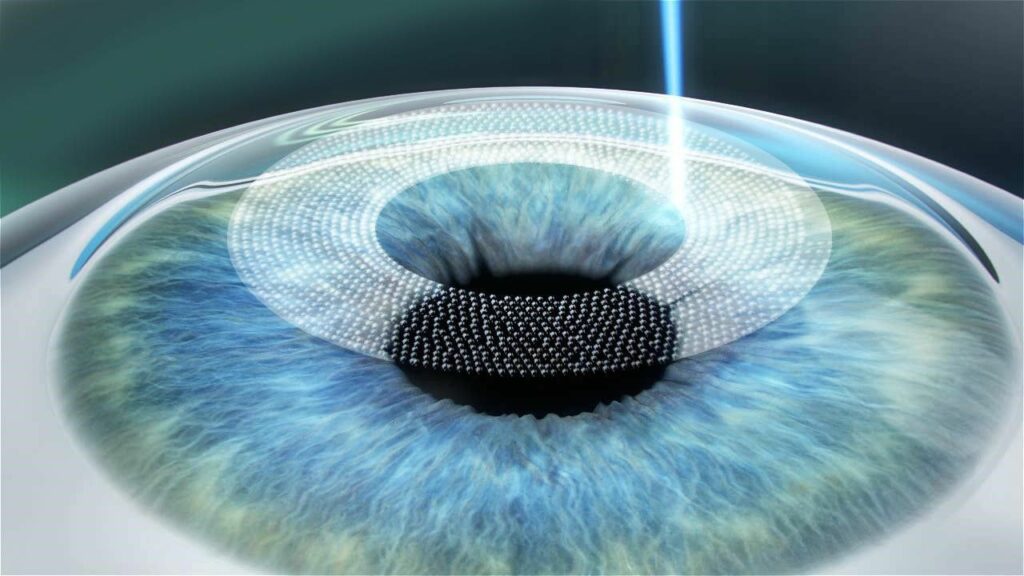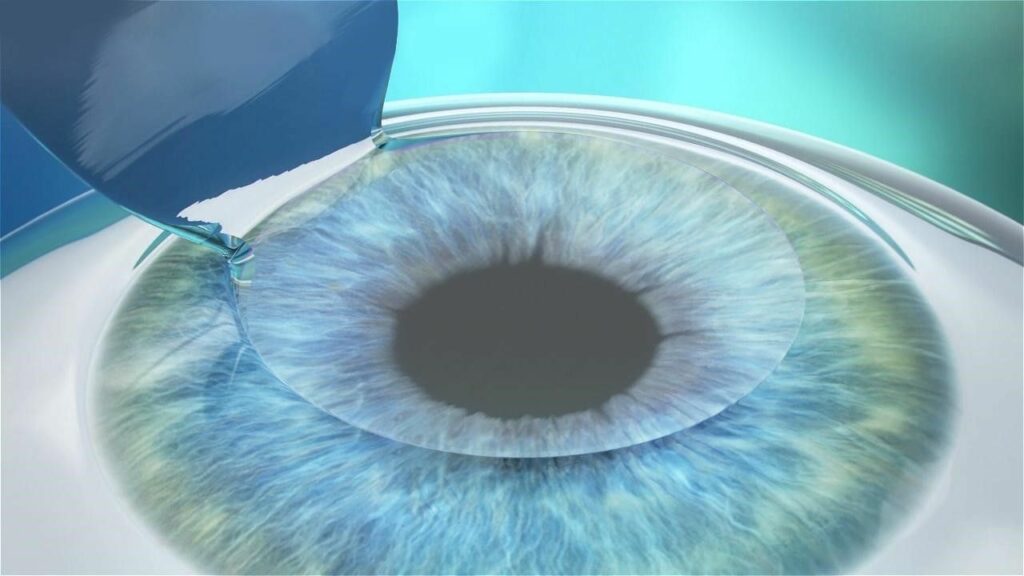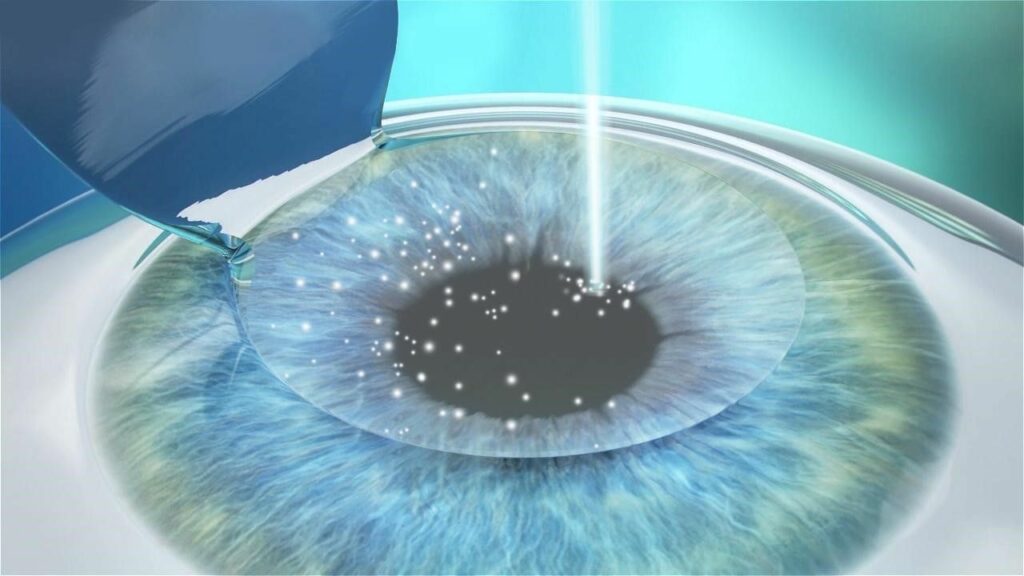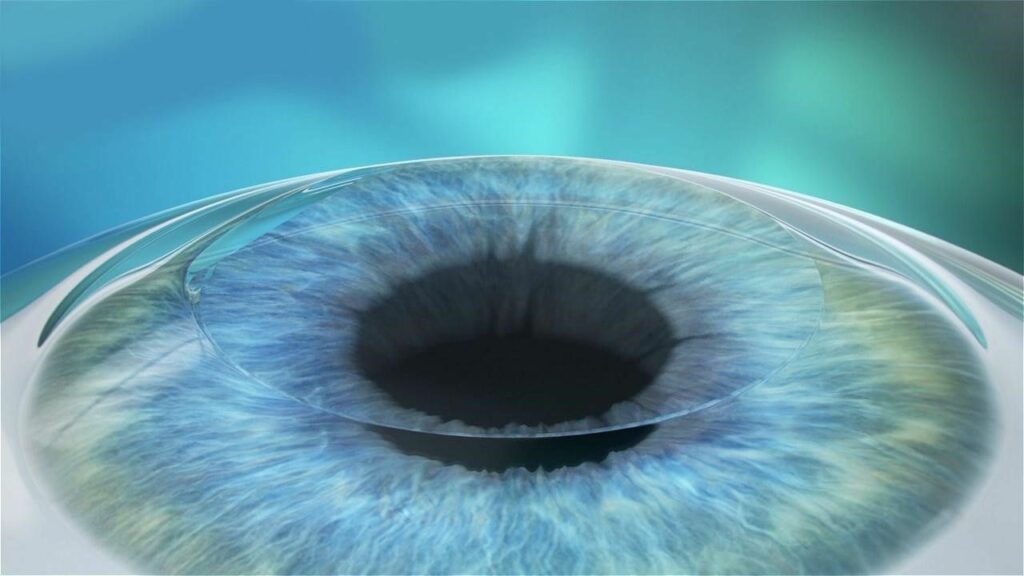
Bladeless LASIK, also known as all-laser LASIK, is an advanced version of the Traditional LASIK procedure in which a femtosecond laser is used to create the flap on the cornea instead of a microkeratome blade. We use the most advanced ZEISS VisuMax Femtosecond Laser.
Traditionally, the surgeon created the corneal flap with a handheld mechanical device (microkeratome) that utilizes a metal blade. This method has worked well over the years; however, the performance of these devices can be unpredictable. With the femtosecond laser, the surgeon uses the precision of a laser to create the safest corneal flap of ideal size and shape. Such precision is important to the safety and success of the entire LASIK procedure. This advanced technology puts unprecedented control in our doctors’ hands, and even allows them to customize the corneal flap for every individual patient.
Step 1: Creation Of A Flap
It only takes 10 seconds of laser time on each eye to create the ultra-thin flap.

Step 2: Lifting Of The Flap
The flap is lifted to reveal the underlying corneal tissue.

Step 3: Reshaping The Cornea
Microscopic amounts of corneal tissue are removed through laser technology.

Step 4: Placing The Flap Back
The flap is placed back in its position, allowing the eye to heal. The eye heals on its own in a few days.

Ultra-Thin Flap Bladeless LASIK has various advantages:

Flap creation with the ZEISS VisuMax Femtosecond laser is a completely bladeless procedure. This groundbreaking laser system employs high-performance Zeiss VisuMax femtosecond laser technology and is characterized by its outstanding flap-making precision, unsurpassed speed, and gentle treatment technique.
By using the ZEISS VisuMax femtosecond technology, our surgeons can create 80 micron ultra-thin LASIK flaps. The creation of ultra-thin flaps ensures a stronger cornea, better visual results, and a significantly reduced chance of developing postoperative dryness.
NIDEK EC 5000 excimer laser system is equipped with one of the most advanced eye-tracking technologies in the vision correction field. Its 200Hz infrared eye-tracking technology follows and responds to tiny eye movements within 5/1000th of a second. This in turn translates into an incredibly smooth corneal treatment surface and faster patient recovery. NIDEK is approved by the FDA for a wide range of nearsighted, astigmatic, and farsighted LASIK corrections. Its sequential treatment of astigmatism and nearsightedness ensures wide treatment zones, optimizing day and night-time quality of vision. NIDEK’s extra-quiet, accurate and rapid treatment minimizes patient anxiety during the treatment and ensures the quickest recovery

If you have Myopia (Nearsightedness), Astigmatism, or Hyperopia (Farsightedness), you may qualify for LASIK.
To be a LASIK candidate, you must meet the following requirements:
Other conditions that can impact LASIK candidacy include Keratoconjunctivitis sicca (KCS), Dry Eye, Amblyopia, Strabismus (crossed eyes), Uncontrolled diabetes or high blood pressure, Immune disorders, and Vascular illness.

Enter your information to have a consultant from 2020 LASIK contact you to schedule a free consultation appointment.
Our Address
2020 LASIK
515 Madison Avenue Suite #700
New York, NY 10022
Text Us
(917) 880-4226
We are now offering zero interest payment options if paid in full within 6, 12, 18 or up to 24 months for patients who qualify through Alphaeon and Carecredit. If you’re interested in financing your procedure with CareCredit or Alphaeon Credit, we would highly encourage you to apply before your consultation. The application process is easy. Simply click here to apply to CareCredit and click here to apply to Alphaeon, submit your application to get pre-approved before your consultation.
How fast will my vision improve?
Your vision will improve very rapidly. Vision may be blurry for the first day, but most patients notice improved vision within a few days of surgery.
Can I have both eyes treated the same day?
Yes, LASIK is usually done for both eyes at the same time. Same-day treatment is preferred by the majority of our patients for added convenience, quicker visual recovery, and less time away from work. However, the preference of our patients will guide us in the treatment plan.
Is LASIK painless?
Yes. Anesthetic eye drops will be used to numb the eyes and there will be NO pain sensation during the procedure.
How much does LASIK cost?
The cost of LASIK Eye Surgery depends on your prescription. The cost is all-inclusive, meaning the price will include the following:
Is LASIK covered by insurance?
LASIK is considered to be an elective procedure and is therefore not covered by most health insurance plans. However, we offer discounts for some insurance companies, and we would be happy to check for you at the time of your consultation.
Is LASIK permanent?
LASIK results in a permanent change to the shape of the cornea. However, it will not prevent age-related conditions such as presbyopia (the need for reading glasses), cataracts, or glaucoma. These conditions would still be treated in their normal manner.